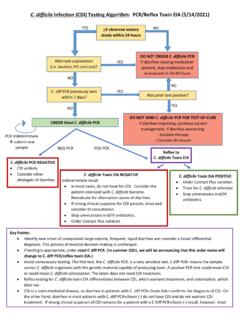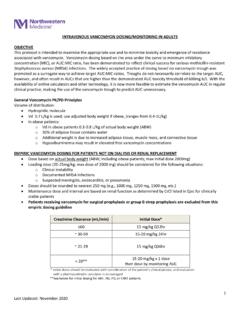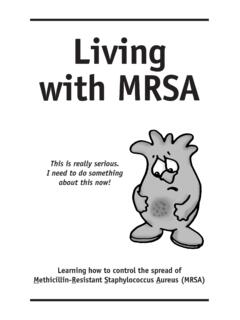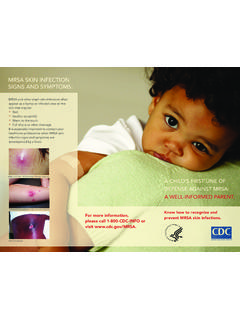Transcription of IDSA Skin and Soft Tissue Infections Guidelines 2014 IDSA ...
1 Skin and Soft Tissue Infection Treatment AlgorithmMildSevereModerateExclusions: Neutropenia, malignancy, severe immunodeficiency, osteomyelitis, diabetic ulcers, bite wounds, animal contact, surgical site Infections , penetrating trauma, fresh or ocean water exposure, viral infection or severe sepsis or septic shock ,or fever with neutropenia Localized infection, no systemic area, or SIRS (HR >90, RR>24, Temp <36 or >38O ,WBC >12000 or <4000 cells/ul. Not IV vancomycinRx: Oral Penicillin or Cephalexin. Clindamycin if PCN : ( if PCN allergy) Blood cultures. Prompt surgical consultation for suspected necrotizing infection. MildModerateSevereI&DI&DWound CultureLocalized infection, no systemic Infections with SIRS ( HR> 90, T<36 or >38O, WBC>12000 or <4000, RR >24 without hypotension) Failed I &D /oral antibiotics, SIRS with hypotension and/or organ CultureEmpiric Rx:TMP/SMX or Doxycycline Empiric Rx: IV Vancomycin.)
2 Change according to culture results Defined Rx: MRSA: TMP/SMX MSSA: Cefazolinor pocephalexin or podicloxacillinPurulent ( MRSA, MSSA)Carbuncles/furuncles/abscessDefined Rx: MRSA:IV vancomycinor TMP/SMX or Linezolid MSSA: Cefazolinor pocephalexin or podicloxacillinDefined Rx for Necrotizing Infection: Strep or Clostridium Penicillin + ClindamycinVibrio vulnificus(marine water exp.) Doxycycline + cefriaxoneAeromonassp. (fresh water exp.) Doxycycline + [ceftriaxone or ciprofloxacin]IDSA Skin and Soft Tissue Infections Guidelines 2014 IDSA MRSA Guidelines 2011 NMH Antibiotic StewardshipNon-Purulent CellulitisBacterial Cellulitis: Look for these reassuring signs of improvement on empiric antibiotics and consider de-escalation to orals Leukocytosis is decreasing. Fever is resolving Pain and tenderness are decreasing Pain medication use is decreasing Intensity of erythema is decreasing; bright redness is changing to brown Heat and/or edema of involved area is decreasing Note: leading edge of erythema may progress despite appropriate antibiotics for the first 2 days: this is not considered failure if there are other findings of clinical improvement, as listed A non-infectious, non-necrotizing inflammatory condition of the skin and/or soft Tissue .
3 These heterogeneous conditions are often confused with cellulitis, resulting in delay in treatment and misuse of antibiotics. Dermatology consult +/-biopsy may be beneficial. Common examples: Statisdermatitis Contact dermatitis Vasculitis Gout Lymphedema Drug eruptionJ Am Acad Dermatol. 2015 Jul;73(1):70-5 Ann IntMed 2005;142:47-55









